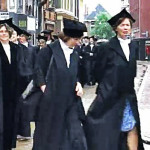Subsidy via the courts
Verheijen, still somewhat perplexed, says it’s surreal. Before he could get the subsidy, a long period of complaints, pleas, appearances before all kinds of committees and, eventually, in court transpired. ‘But of course I’m ridiculously happy.’
It’s quite unusual for a researcher to fight for a subsidy so hard, especially for such a big subsidy like a Vici. ‘But I thought I had a winning ticket’, Verheijen says. ‘And the support I got from the legal department General Administrative and Legal Affairs (ABJZ) from the RUG was a huge help.’
Piece of cake
Now, two years later, he can finally recruit PhDs and post docs to work with the special camera that he and a team from ASTRON built for the radio telescopes at Westerbork. With it, researchers can study the hydrogen gas surrounding 10,000 galaxies in order to gain more insight into the role of hydrogen gas in the evolution of the universe.
Originally, Verheijen submitted his application for the 2012 round of Vici subsidies. The external experts initially put his proposal in a shared first place. ‘An A plus’, he says. ‘I thought then – quite presumptuously – that it would be a piece of cake.’
Falling short
But after the next step, the science-wide jury of NWO, the proposal fell short. ‘In the large committee, there was only one astronomer. The rest were from different fields – there was a professor of real estate finance, for example. That’s quite far away from my area of expertise’, Verheijen says.
That’s always how it’s done, NWO spokesperson Olivier Morot says. The science-wide committee has to ensure that the best proposals are selected, regardless of the discipline of the applicant.
Verheijen recognises that NWO gets to do that, but the motivation behind the rejection didn’t make sense. ‘They found that the scientific motivation for the project wasn’t original, because I had already used that motivation in the request for the investment subsidy to build the camera.’
Nonsense
He thinks that’s nonsense. Why would a different motivation be necessary for building the camera rather than for the use of it?
NWO spokesperson Olivier Morot confirms that the motivation was the reason for the rejection. And unfair application of the criteria was the reason that Verheijen’s appeal was founded. ‘There was an ad-hoc committee formed to assess the proposal again’, he explains. ‘But that committee also didn’t prioritise the project highly enough.’
‘There was no clear motivation and no scenario given for a re-assessment’, says Verheijen. ‘What’s more, NWO diverged from the original assessment protocol in doing so.’
A confidential committee assessed the project, but it was compared to other science projects instead of proposals from all disciplines: one proposal that had just been accepted for a Vici, and one that just fell short. ‘Plus, I wasn’t invited for an interview, which is normally what happens.’
Very good
A court date followed, and the judge agreed with Verheijen’s appeal. The judgement of the committee had not been applied fairly.
‘Then, NWO decided to award the subsidy’, Morot says. ‘Of course, Verheijen’s proposal had just barely fallen short, which means that it was really very good.’
Verheijen is happy and relieved. He hasn’t lost much time, either. It took longer than expected to get the unique APERTIF camera up and running. ‘But now, it’s as good as done, and I have the resources to recruit two post docs and two PhDs and to buy a super computer that can analyse the signals from the camera.’ Verheijen expects that his new team will begin working after the summer.






